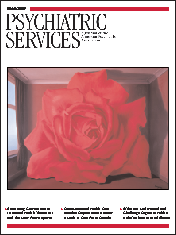Prescribing Behavior and Marketing Practices
To the Editor: The article in the January issue by Valenstein and colleagues (1) about the diffusion of a new antipsychotic in the Veterans Affairs (VA) health system is a useful work of reportage. However, it neglects one crucial variable, namely, the role of pharmaceutical marketing practices. As a VA clinician, I have observed a familiar series of events, in which pharmaceutical representatives first advocate the addition of their product to the formulary and then follow up with written materials and presentations, when permitted, once the new agent has been approved. Peay and Peay (2) in a study on the introduction of temazepam have shown that the most significant factor in altering physicians' prescribing was commercial sources of information. Orlowski and Wateska (3), in a study of agents similar to one another, found that differences in prescribing were attributable to attendance at a company-sponsored vacation symposium.
The pharmaceutical industry employs an array of sophisticated interventions to alter prescribers' behavior. The least we can do is to recognize their existence and study their impact. On the basis of that evidence, further responses and safeguards can be developed.
Dr. Stone is psychiatrist and codirector of the PTSD clinical team at the Philadelphia VA Medical Center and clinical associate professor of psychiatry at the University of Pennsylvania.
1. Valenstein M, McCarthy JF, Ignacio RV, et al: Patient- and facility-level factors associated with diffusion of a new antipsychotic in the VA health system. Psychiatric Services 57:70–76,2006Link, Google Scholar
2. Peay MY, Peay ER: The role of commercial sources in the adoption of a new drug. Social Science and Medicine 26:1183–1189,1988Crossref, Medline, Google Scholar
3. Orlowski JP, Wateska L: The effects of pharmaceutical firm enticements on physician prescribing patterns. Chest 102:270–273,1992Crossref, Medline, Google Scholar



